
Dear friends,
In Prague on August 21, 2023
Introduction
Thank you for the invitation to the next Road to the Summit discussion series, "A Tale of Two Summits." It was an opportunity to penetrate deeper into the UN agenda's structure understanding, e.g., of the "Twin Summit" (Summit SDG, September 2023, and Summit for the Future (SFTF), September 2024, both followed by the World Social Summit, 2025).
Millennium is an unquestionable milestone (it is an emotion) on one side, and the passing years mean nothing more than the Human performances continuity in the Great Triad (GT) on the path to the next millennium.
The first "libretto" of the path of the Human, his/her success, or failures in the GT environment, outlines the UNSDG, 2030 Agenda in steps every 15 years (via MDGs and SDGs). The critical works were seeded, harvest is close, and planned yields look neither convincing nor readable.
Such a view is probably the truth for the two remaining years. In any case, the UN's path is exemplary work for me. It inspires the present generation to penetrate the depth of knowledge at the global level and act better in the following steps (years).
When I think about how to help, I can think of adding more stimuli to my call of 7/21/2023. I will start with a dialectic diagram according to Figure S01 (originally, it is Figure C3c.2; other Figures relevant to the Website & Webbook are in this text marked and, in any needs, can be open on www. 5pforres.eu).
The Dialectic Diagram, DD, is a straightforward method presented as unsuitable for any hasty and scornful approaches. It is a purposeful tool, is not primitive, and is helpful for a broad spectrum.
Figure S01 Principles of cohesion of goals and paths methodology
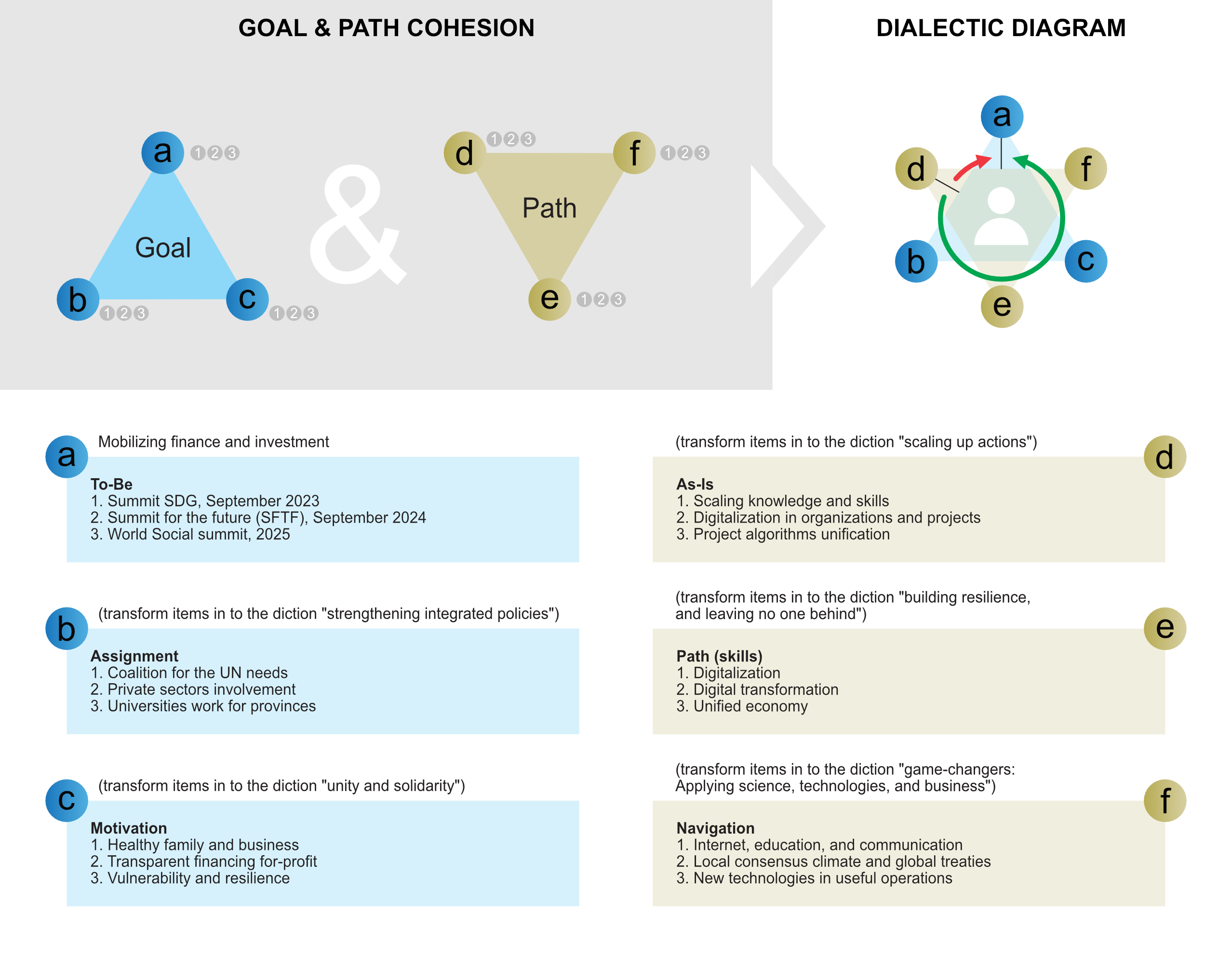
How we can read this diagram:
Goals and paths to them have their three-valued content (their triad). Through their intersection, we get the algorithm's structure of their transformations for one cycle and subsequent processes.
We distinguish what:
- Goal triad says: when I have already set a goal (To-Be), I must also develop a task (b) how to reach the goal and with whom and why (c). I must find the weight of motivation for the purpose.
- The path triad says: if I want to reach a goal, I must know how I am doing and what assumptions for inputs I have created in the past (for the As-Is decision-making stage). After that, I can build a plan of my path (e), but I must consider the surroundings, which will navigate me (f) for better or worse.
By projecting the triads onto each other, we get a dialectical diagram that can be read in two directions. The red line (toward the o'clock hands) is attractive, fast, and often applied but is not useful direction.
It is a toxic non-transparent, emotional, misleading, tricky, and too fuzzy approach, risky for digitalization. It is said, who is not ready enough, cannot succeed in the holistic world.
The green direction has a holistic nature. It builds algorithm thinking and offers a basis for applying a hierarchy of algorithms in the packages of activities of milestones representing cycles of comprehensive operations, which we commonly call projects.
The green direction can be read as follows: we know the goal (a), have inputs (d), and assignments (b) on the table. The plan of the paths can be completed (e) to prepare motivation (c), and navigation (f) is gaining visibility.
The chance to reach the goal will increase if we can manage the risks and correct the mistakes of partial decisions step by step. Figure S01 obtains a direct link to the "Twin Summit" theme by specifying in more detail the contents of the packages (in items 1, 2, 3) linked to the milestones (a, b, c, d, e, and f).
Figure S02 Vision and mission protocols scaling on a strategy level

Figure S02 rewrites the dialectical (cyclic) to process (linear) diagram. It represents a chain of tasks defined by standard procedures for processing the background of the vision and mission.
It's about how to write a road map, a plan for your journey to your destination. These traditional (standard) document management approaches specify a task, determine project algorithms, monitor task execution, and control its procedures through sub-task packages and process milestones (in other words, how to build a task project).
In the "Vision-Mission" mode (Figure C8d.1) of thinking about goals and paths, we move from the As-Is state (how we are when we start) to the To-Be state (where we would like to be, seen through the eyes of the As-Is state). Agenda 2023 generates and seeks to manage a broad portfolio where their timing definition becomes a severe issue.
The Agenda 2023 seeks the consensus of the actors, but their "words," which ultimately confirm or reject the consensus (agreement), do not arise at the "table," where they act, but have their content in the processes of preparation and implementation of SED, DRR, and HA projects worldwide (Figure W11). The form of their words is bound to the actors' historical, professional, and cultural roots (e.g., in LIC and HIC environments).
Finding a consensus for many "words" when loaded with many different influences (e.g., the habits of the local population and the availability and equality of their opportunities to access the Internet, financial, health, and other services) needs patience and appropriate tools.
A dialectical diagram introduces a practical philosophy (logistics) approach (Figure C2b). Both for the preparation and actual actions of the actors, as well as for the processing and storage of data, for supporting patients to act and have results repeatedly.
An example is rewriting the SDG Summit Program into the DD structure. There are two questions associated with this procedure:
- How can we read (better understand) the spectrum of the six "Leadership Dialogues" (their content and structure) that will take place next month (September 18-19, 2023)?
- Why is DD presented now before these dialogues begin?
DD will give us the answers.
First, we can have a structure at hand, a valuable methodology for data processing, and the acquired knowledge processed, stored, and used in algorithms suitable for digitization. Second, we can implement the necessary procedures and principles into the SDG Summit's conclusions at the right time in September 2023.
The summit organizers have no doubt considered this, but it is tempting, for example, to prepare the next Summit for the Future (SOTF), September 2024, in a digital structure. If we should accept this thought, it stands to reason that it is high time to start.
The original "Leader's Dialog" Program offers six packages with six milestones with a specific function: to use the potential of the SDG Summit to MOVE the 2030 Agenda towards its goals. I chose two steps for the potential application of DD.
The first was the arrangement of the sequential logic and contents of the "Leader's Dialogs (LD)" packages into the structure of the Dialectic Diagram (DD). The second step is to shorten (simplify) package names to support orientation in the graphical representation of cycles and data dynamics in DD.
In the Summit SDG Program, DLs are sorted by numbers (1 to 6), and DD corrects their order according to its methodology (sorting logic). According to the Program, nothing needs to be changed for the meeting. Still, it is recommended to capture data and information in the form of drafts, comments, and additions after the end of the Summits already in the DD structure and continue to work with it.
DD offers space for two operations.
The first represents a cyclic diagram that can be used for debugging and organizing the acquired data and information into a DD structure for further cyclic (patiently) debugging.
The second space offers a grading dynamic diagram based on the scale of the consensual agreements on a cycle of milestones and packages (tasks) tied to set homework. It allows for collecting data and information and working with them digitally (e.g., Figure C4e.1).
It demonstrates an opportunity to deal with the digitization of the Summits agenda until 2030. The fact that it will not be easy, and what the beginnings are, is shown by the example of rewriting the SDG Summit Program into DD logic. For example:
Original diction and deck order LDs for discussion:
- LD 1: Scaling up actions on critical transitions to accelerate SDG progress.
- LD 2: Building resilience and leaving no one behind.
- LD 3: Game-changers: Applying science, technology, innovation, and data for transformative action.
- LD 4: Strengthening integrated policies and public institutions for achieving the SDGs.
- LD 5: Unity and Solidarity: Strengthening the multilateral system for enhanced support, cooperation, and follow-up and review of the SDGs.
- LD 6: Mobilizing finance and investments and the means of implementation for SDG achievement.
Transcription of LDs in shortened diction for better graphical clarity:
- To-Be for LD 6: Mobilizing finance and investments
- Assignment for LD 4: Strengthening integrated policies
- Motivation for LD 5: Unity and Solidarity
- AS-Is for LD 1: Scaling up actions on critical transitions
- Paths for LD 2: Building resilience and leaving no one behind
- Navigation for Dialog 3: Game-changers: Applying science, technology, and business
The LD's original Program offers six packages with six milestones with a specific function: to utilize the potential of the SDG Summit to SHIFT the Agenda 2030 to its goals. The transcription presents the following Figure.
Figure S03 SDG Summit program (Leader’s Dialogs in the Dialectic Diagram)
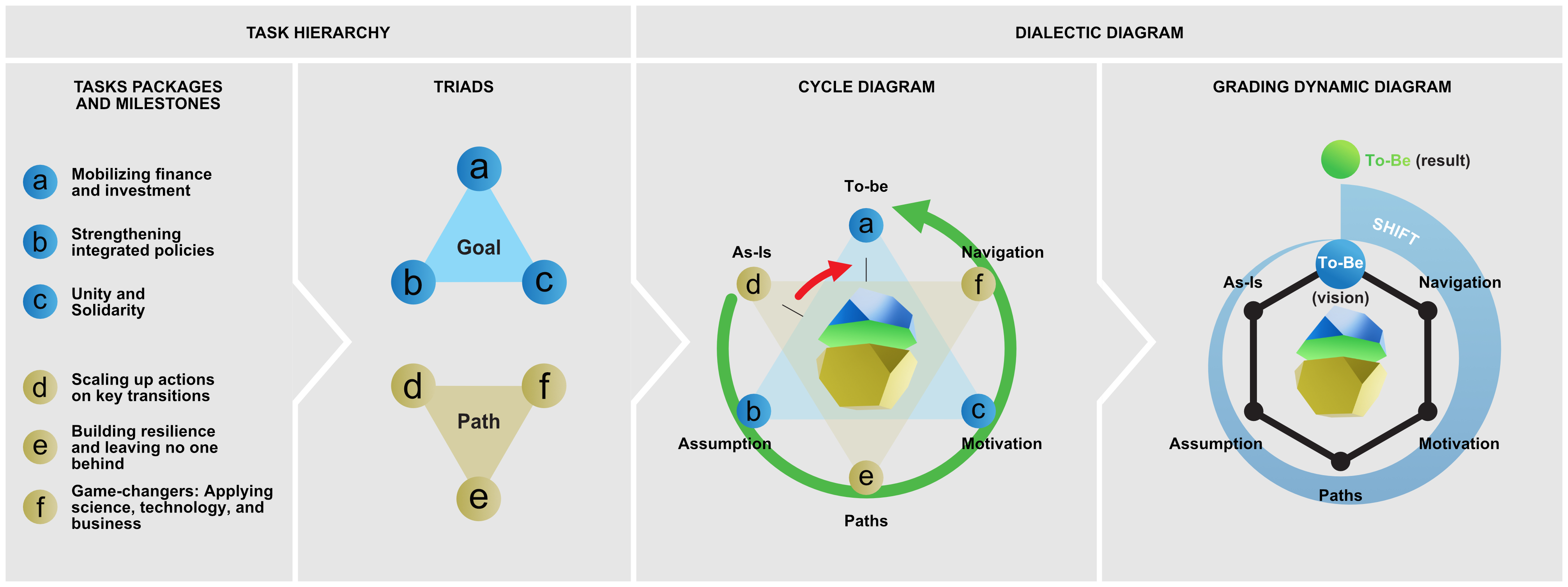

To-Be: Leaders’ Dialogue 6: “Mobilizing finance and investments and the means of implementation for SDG achievement.”
This Dialogue will address finance, investments and means of implementation for SDG achievement. There is a need to match abundance and responsibility with global, national, and local commitments to deliver on financing, galvanize leadership and restore the trust that will place the world on course to achieve the SDGs by 2030. The Secretary-General has encouraged Member States to deliver on an SDG Stimulus, to ensure that developing countries can deliver on the SDGs and to advance deep reforms of the international financial architecture. This Dialogue is also conceived to connect the SDG Summit with the High-level Dialogue on Financing for Development to be convened during the General Assembly High-level Week in September 2023.
Guiding questions to serve as the basis for the commitments:
- What immediate measures can be taken to implement the SDG stimulus, especially on debt treatment and providing long term and affordable liquidity, including through investments?
- How to generate political momentum for reforming the international financial architecture to make it fair and better aligned with the objectives of sustainable development.

Assignment: Leaders’ Dialogue 4: “Strengthening integrated policies and public institutions for achieving the SDGs.”
This Dialogue will serve to advance policymaking which considers interlinkages between the SDGs and spillover effects, and to strengthen public institutions to this end. A central tenet of the 2030 Agenda for Sustainable Development is a holistic approach to SDG implementation. This includes harnessing synergies where action in one area can also generate positive impacts in another, while also addressing trade-offs.
Guiding questions to serve as the basis for the commitments:
- What capacities are needed to further strengthen integrated approaches for action across the SDGs, and what are the major obstacles?
- How to ensure that SDG transformations effectively deal with cross-dimensional impacts?
- How to enable public institutions to better apply integrated policies and manage the trade-offs?
- How shall the UN and governments benefit from the contributions of civil society and other stakeholders in a more efficient and inclusive manner?

Motivation: Leaders’ Dialogue 5: “Unity and Solidarity: Strengthening the multilateral system for enhanced support, cooperation and follow-up and review on the SDGs.”
The international community needs to deliver on the outstanding promise of the 2030 Agenda for Sustainable Development. Yet recent global shocks have highlighted the weaknesses and inequities of the current multilateral system. This Dialogue will contribute to strengthening unity and multilateralism, particularly through international cooperation and trust-building, including as it relates to follow-up to the Secretary-General’s report on Our Common Agenda. It will consider avenues and opportunities to augment the follow-up and review of SDG progress. Member States can also give guidance to facilitate the continued strengthening of the United Nations Development System to support the transformative changes envisioned in the 2030 Agenda.
Guiding questions to serve as the basis for the commitments:
- How can the United Nations work better with other institutions to accelerate the achievement of the SDGs?
- What areas of follow-up and review of the 2030 Agenda and the SDGs could be strengthened for the greatest impact on delivery?
- How can the Global Partnership for Sustainable Development be urgently revitalized?

As-Is: Leaders’ Dialogue 1: “Scaling up actions on key transitions to accelerate SDG progress.”
Achieving the SDGs by 2030 requires key transitions pursued through bold decisions, a surge in investment, and long-term holistic approaches. This Leaders’ Dialogue will concentrate on policy actions and investment pathways to drive these transitions that will act as multipliers to advance progress across the SDGs, including in areas such as energy, digitalization, education, social protection, the triple planetary crisis, and food security.
Guiding questions to serve as the basis for the commitments:
- What actions have been successful in bringing about transitions for sustainable development?
- How can these actions be scaled up to unlock the rapid and deep transitions needed to deliver on the Goals?
- How can multi-stakeholder partnerships and collaboration contribute to SDG progress through key transitions?

Path to Goal: Leaders’ Dialogue 2: “Building resilience and leaving no one behind.”
This Dialogue will consider the profiles of resilience that demonstrate humanity’s capacity to overcome adversity. The world must act to tackle the drivers of socioeconomic inequalities within and between countries, and improve the well-being of people furthest behind, especially marginalized, and vulnerable groups, and thus contribute to inclusiveness and resilience globally. Local and indigenous approaches to building resilience and wellbeing can be introduced in the discussion. The dialogue will also address disaster risk reduction and disaster resilience as well as advancing the SDGs in crisis and humanitarian settings.
Guiding questions to serve as the basis for the commitments:
- How can rapid technological change enhance resilience and ensure a people-centered and human rights-based approach to sustainable development?
- What concrete and ambitious actions can be pursued for safeguarding the wellbeing of all in society, leaving no one behind?
- How can child-sensitive and gender-responsive approaches be bolstered and brought to scale, especially focusing on the needs of youth?

Navigation: Leaders’ Dialogue 3: “Game-changers: Applying science, technology, innovation and data for transformative action.”
The world is equipped with levels of knowledge, technologies, and resources that are unprecedented in history. Yet the potential for science, technology, innovation, and data to be applied to the SDGs is vastly under-utilized. Systemic and contextual barriers that stand in the way of their effective and equitable utilization also need to be identified and eliminated, including with respect to the participation of women, girls, and minority groups in STI. The Dialogue will facilitate a discussion on the most effective entry points to bring to bear scientific knowledge, technologies, and data in accelerating SDG implementation.
Guiding questions to serve as the basis for the commitments:
- How to advance innovative approaches and solutions to the application of new technologies and practices to accelerate and scale up SDG achievement?
How can science, technology, innovation, and data be applied coherently and strategically to make game-changing transitions? What measures can be taken to strengthen the capacity of developing countries in utilizing science, technology, innovation, and data for transformative action?
Work on the inputs for the diagram in Figure S03 highlights some of the issues mentioned above. Every word, its understanding, and acceptance in the environment of many people (billions) has its weight.
Fortunately, AI is helping. The quality of translations is increasing, and standards for grammatical sentence structure applications are at hand. In this direction, especially English is growing. But that's just the beginning.
Other problems come with perceiving the temporal distinction of the meaning of As-Is and To-Be (what is now is based on what was, what will be, may not be, or will turn out differently than we now wish or forecast).
Almost all of us know this; however, especially at the policies (strategies) level, the timing of what is on the table and what we would like to have been underestimated.
Words (at the levels of strategy, tactics, and operations) must deal with the absorption of many influences (historical, cultural, and intriguing in the context of various knowledge, argumentative, and situational colors or backgrounds). Finding consensus for the word is not easy.
So that the word and the words in the sentences are mostly accepted (accepted) or at least respected is a problem that has been old for millennia. Again, this is common knowledge, especially at the UN level. However, something is still happening.
The offer is a synergy of AI technological progress and the philosophical stimulus represented by DD applications. It includes the characteristic (design methodology) where words or combining words can be put into a formalized structure (algorithm) in a unified structure, for example, in the case of the Agenda 2023 document.
It is an example where AI risks are real but manageable, (e.g., through internal public controls at the highest human level in the GT environment).
It is a challenge for the work of interdisciplinary and international teams that can be called upon to collaborate, perhaps as early as October 2023.
The environment for such cooperation is beautiful and undoubtedly catchy if the preparation and execution of the selection process support it. Such an environment suggests in Figure S04.
It introduces an approach to philosophy via tasks of the Human that he/she needs so to protect and build his/her sustainability and well-being in the G.T. Presents three levels of the triad concept, each one for one class. The "game-changer" influencers on the science and technology level accompany policy (strategy), tactic, and operational levels.
Figure S04 reacts to differences among LIC, LMIC, UMIC, and HIC environments. It is trying to say what is a common destiny, what indicates dramatic differences in the paths of thinking (e.g., the difference between L.A.S.E.R. and SPC Drivers content (E2, E3, E4, and E5), and where we can start cooperating immediately (e.g., on the New Project Paradigm, NPP (Figure C5e) development and dissemination)
Figure S04 Hierarchy of tasks and distribution approach principles understanding
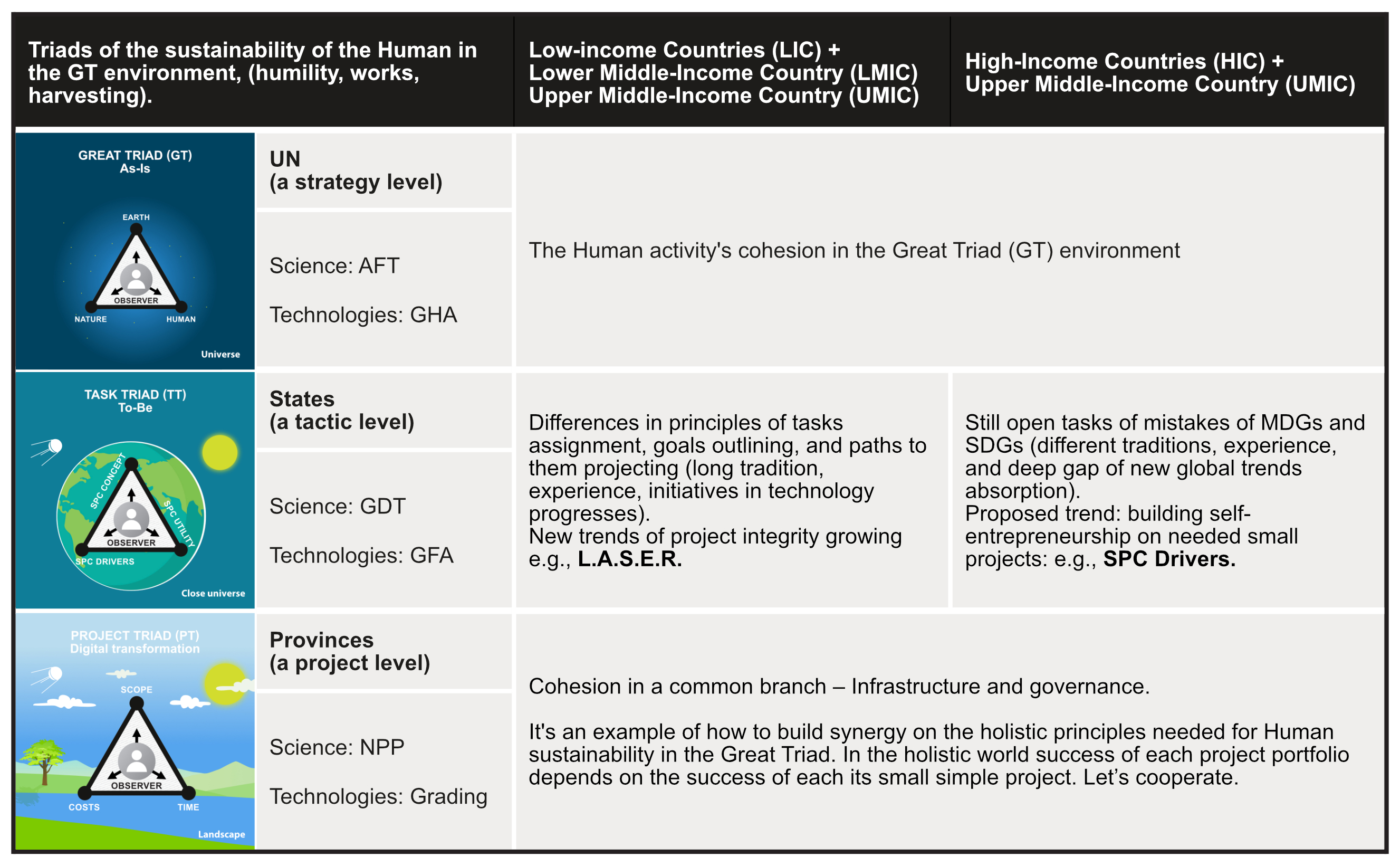
AFT: Algorithm Framework Theory (in discussion) for economics, social sciences, and the humanities, with a direction toward a unified social science.
GHA: Global Human Adaptation (proposal) reacts to the needs of the resilience of the Human to threats (e.g., new technologies, climate change, pandemics, wars).
GDT: Global Digital Transformation (proposal) reacts to the needs of the SHIFT in favor of the global digitalization development and sustainability in this century (reaction on fission/division of digitalization procedures/algorithms on plenty of different levels).
GFA: Global Financial Architecture (discussed) to safeguard the stability and function of the global monetary and financial systems (e.g., via Multilateral Development Banks, MDB). For the LIC, new initiatives are rising (e.g., Digital Public Infrastructure, DPI, is a powerful tool for reducing poverty).
NPP: New Project Paradigm (proposal), intending to be the principal tool of processes aimed at the GDT and GHA projects transformations on both global and local levels.
Grading is about the global internal control mechanism of finance and investment via the pilot apps of the Self-Powered Community initiative: SPC Concept, SPC Utility, SPC Drivers, and SPC Diamond.
Figure S05 The SPC Diamond grading methodology (proposal)
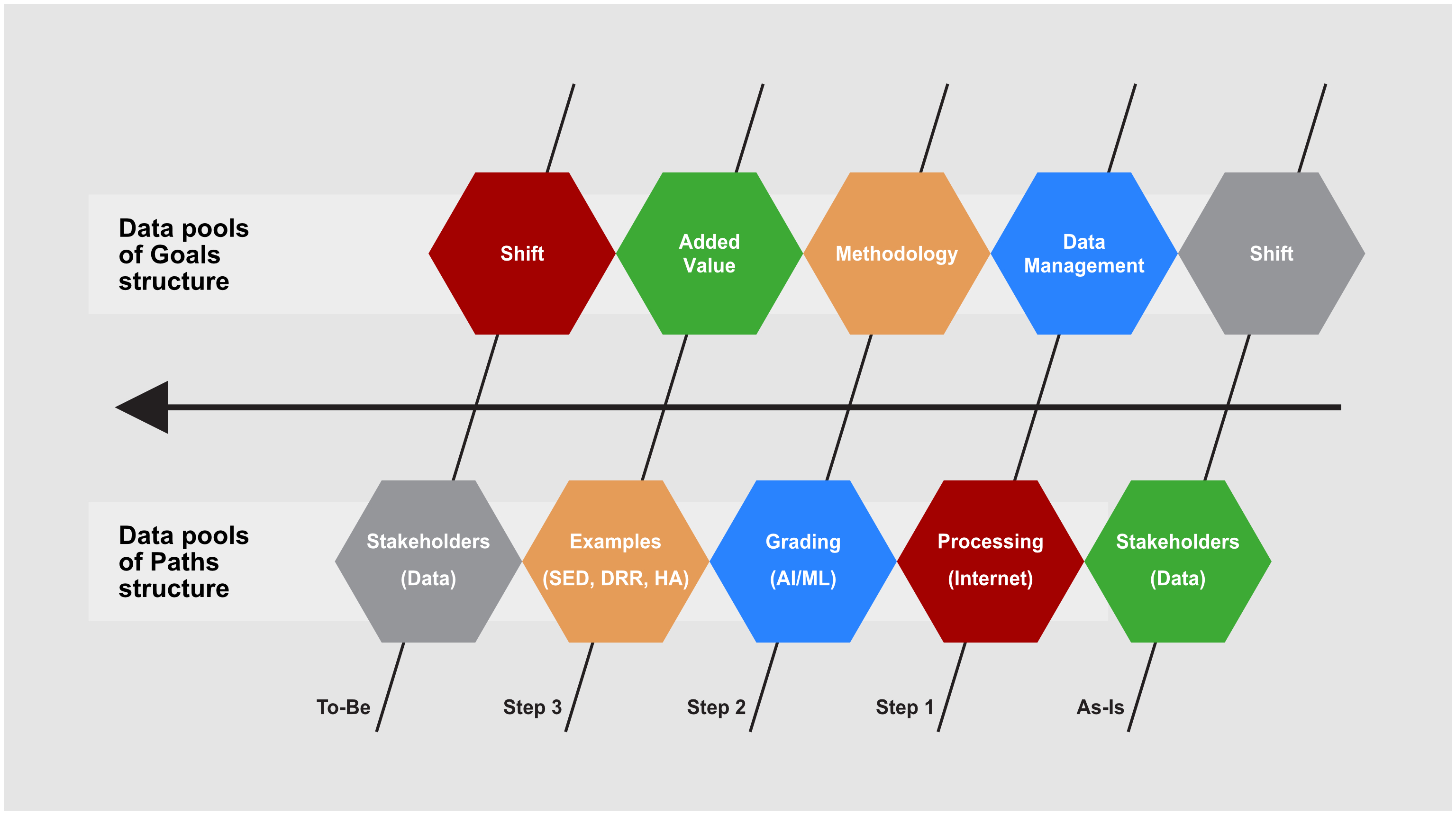
Figure S05 is linked to the preparation of the SPC Diamond methodology for developing applications of indicators and criteria of the global assessment system.
The system is built on the model of "diamond anatomy" and the position of the natural diamond as a globally respected and measurable value. The model is being prepared on the Web and Wobbook (W&W) of the author of the text (more in Sub-Chapter C7).
Figure S05 presents its primary "facets," namely data pools on its upper and downsides. It is an example (proposal) of linked data fields of the project life cycle (project profiles) in both the position of the project goals and the paths that lead to the goals.
A distinction is made between the actual As-Is states at the start of the project and the imaginary, assumed forms that acquire values only after the end of the project.
"Facets" are received as strings of data files (packages of data and milestone positions in the project cycle). If we suppose an example of a project is given, then the functions of pointers, indicators, and evaluation of significant details and units are running in the mode of the chain of milestones that the project fulfills.
Between the As-Is and To-Be states, SPC Diamond offers three steps to monitor carrier polarities:
- Step 1: Digital (multi-purpose) application of project processes on the Internet with support for maturing administration and data storage functions.
- Step 2: Development, anchoring, and dissemination of project evaluation methodology (generally supporting results) with the assistance of the increasing progress in AI/ML applications.
- Step 3: Monitoring the results and progress in the quality of projects on the SED, DRR, and HA spectrum of project preparation and implementation, on a pilot basis, in the LIC environment.
The goal is SHIFT, as a proven (consensually acceptable) way of improving the behavior of stakeholders (in this case, by way of projects that serve them with an emphasis on the LIC environment, on small projects in SPC Drivers assignments).
Figure S06 The gaining of the holistic view on being (sustainability) of the Human in the GT
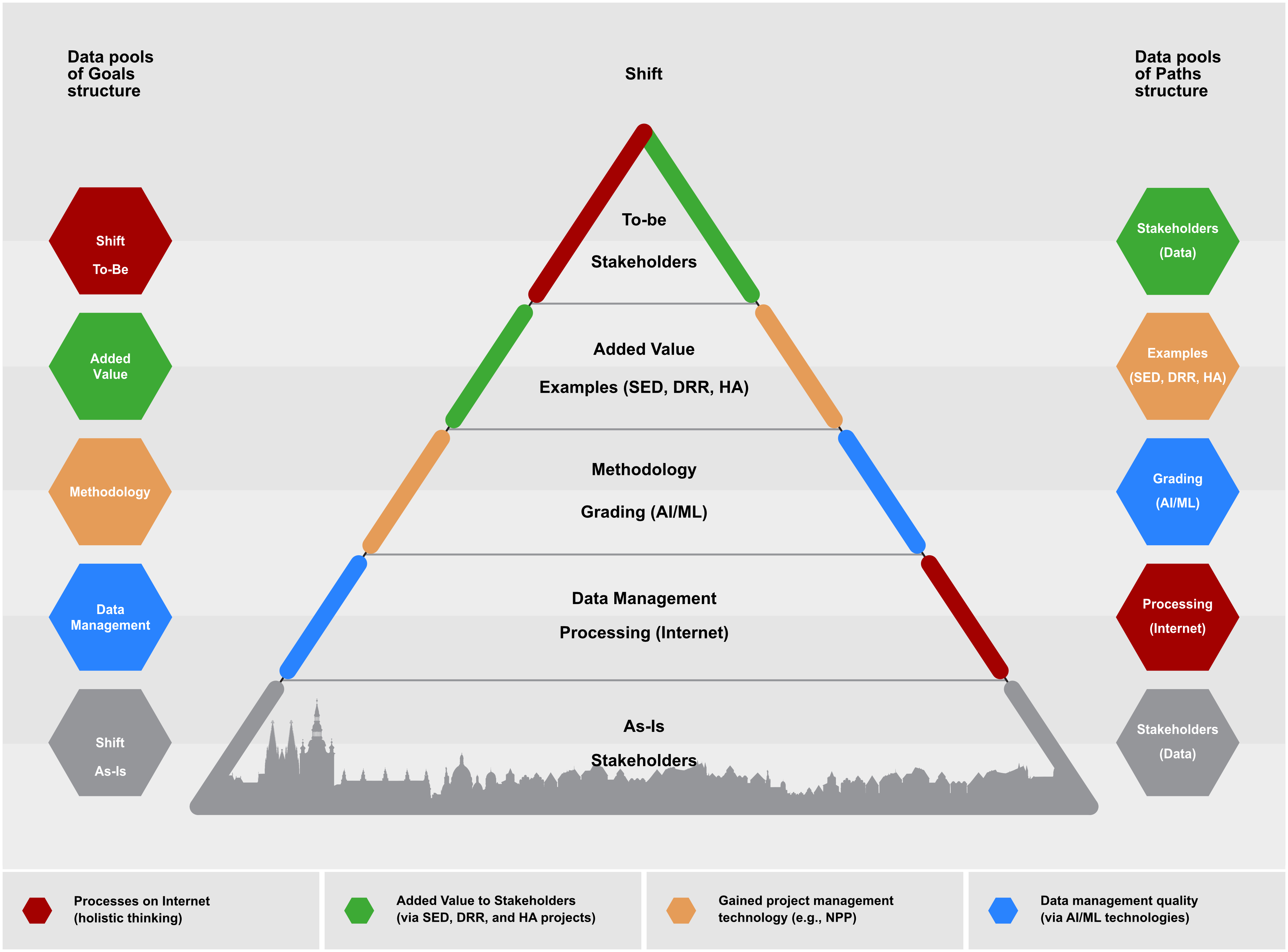
The function and meaning of the SPC Diamond are further elaborated in Figure C06. It specifies the SHIFT of stakeholders in more detail, namely their maturing into holistic positions.
In other words, they into a position that will allow them to communicate with machines that involve (computers) and later absorb situations demanded by machines, e.g., via SPC Utility, into the processes of project preparation and implementation.
It is a rewriting of ordering "facets" in chains shaped like a pyramid. The reason is the visibility of the hierarchy of data files, their paired relations, and functions (identification via colors).
It an exciting theme that shows the need to supplement the missing evaluation methodologies or replace often confused and inconsistent procedures.
This area of innovation and invention awaits professional judgment as to whether and how to proceed. In this matter, I believe in a shift towards professional international and interdisciplinary cooperation in a network of teams cooperating online on the Internet.
The condition is that this direction of intellectualization of the Human in the environment of the GT gains a head, more precisely, a position from which the problem of "Grading" will be solved worldwide, whether as SPC Diamond or otherwise.
An opportunity is presented to demonstrate the understanding and practical application of DD on the content of this text. The text contains six Figures (sub-chapters) in the logical writing order:
- (e) Figure S01 Principles of cohesion of goals and paths methodology.
- (d) Figure S02 Vision and mission protocols scaling on a strategy level.
- (f) Figure S03 SDG Summit program (Leader's Dialogs in the Dialectic Diagram).
- (b) Figure S04 Hierarchy of tasks and distribution approach principles understanding.
- (c) Figure S05 The SPC Diamond grading methodology (proposal)
- Figure S06 The gaining of the holistic view on being (sustainability) of the Human in the GT.
Then we resettlement the titles of Figures (sub-chapters) into the DD structure and shortened their diction (for graphical clarity). So, we finally gain inputs for the Figure S07:
The goal inputs: we must be motivated, ready to generate, fulfill, monitor, and evaluate assignments, and so gain opportunities to be more holistic.
- (a) The gaining of the holistic view
- (b) Hierarchy and distribution approach understanding
- (c) SPC Diamond grading (proposal)
The path inputs: we should be pragmatic and utilize navigation services on paths to our goal, but it will help only when we know ourselves and our surroundings.
- (d) Vision and mission protocols
- (e) Cohesion of goals and paths methodology
- (f) SDG Summit evaluation
Figure S07 Dialectic Diagram example – a test of validity
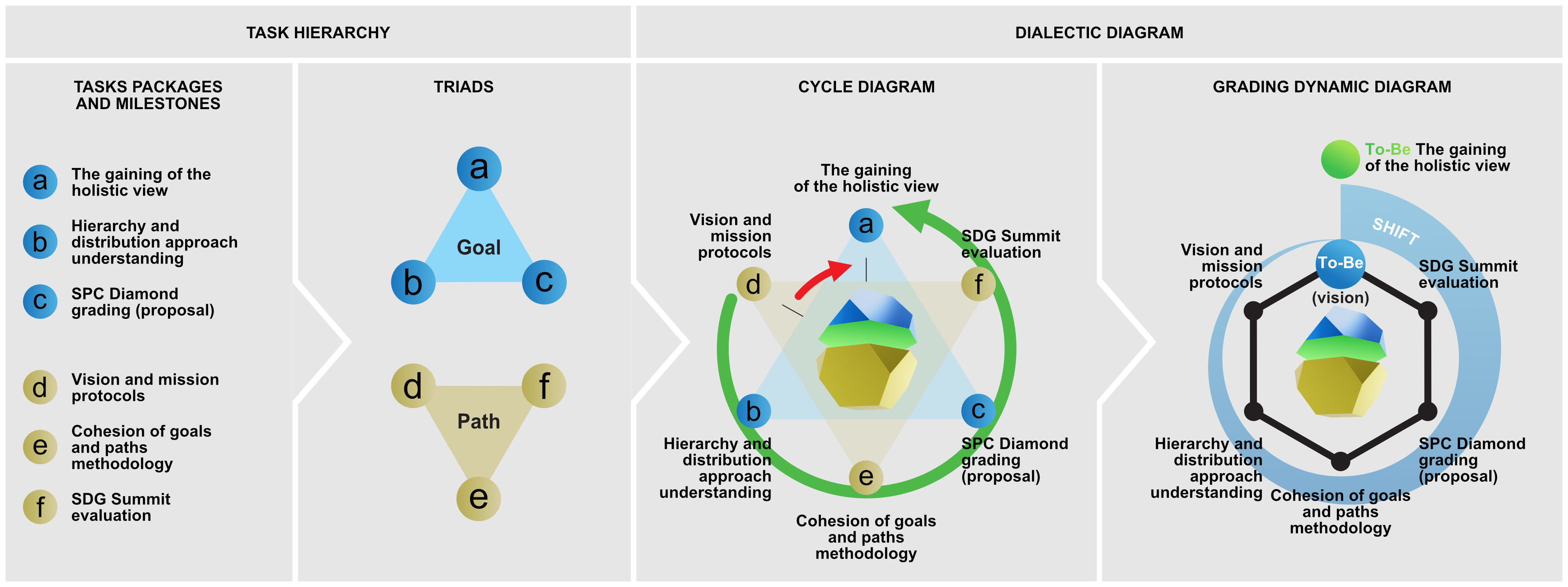
Summary of the DD apps
How can we read DD by Figure S07?
It is not enough to decide to apply synergistic approaches, work or speculate, and believe I will achieve comprehensive, holistic results. Only the decision, the mere declaration, is the red line in DD.
The path leads to the green. To be more holistic, we must learn how to generate, set, and complete tasks and devote ourselves to the motivation to persevere on the journey to the goal. It will probably be possible if we know ourselves well and the environment we enter. Then let the navigation help us, no matter where it comes from.
In walled diction, DD can be read according to Figure S03.
Based on the results of work on the Millennium Development Goals (MDGs 2000-2015) and Sustainable Development Goals (SDGs till 2030), we have a clear idea of what Man needs to sustain and live a whole life in the GT environment.
Suppose we can enter this clearly and describe it with by the milestone As-Is: Increase of actions at critical transitions and demonstrate strengths and weaknesses of us people and the GT environment. In that case, we can continue the Agenda 2023 journey in good faith. Milestone Path: Building resilience and leaving no one behind will lead us.
What the previous ones demonstrated, and what this Summit is about to do, is attract stakeholders, supporting their motivation to participate. Milestone Motivation: Unity and solidarity is this direction's "golden" thread. But it needs to improve so the motivation does not become a critical point of DD cycles.
Navigation is about the authority (personality) of the object who realizes they need navigation. Navigation contains intelligent and profitable tasks. Navigation must come alone. Compelling them by force or through unsuccessful speculations and copies is complex and, from a middle and longtime perspective, contra-productive.
Navigation means the application of science, technology, and business is the choice of the "Game-changers," it is about their freedom choice to participate in synergy and co-harvest results (e.g., via blending finance).
It is the principle of paths to the goal, from state As-is to state To-Be. DD operates as a "never-ending file of processes" and repeatedly generates data, contributing, e.g., to growth in the "Big Data" phenomenon. It is the way to approach the processes of living Nature and the Universe. It is the journey of the Human learning about a deeper understanding of the GT environment.
The author of the text recommends supplementing by adding a complex graphic presentation of the SDGs with a simple and understandable verbal diction (declaration) of what the upcoming Summits want and what paths they want to take to reach the set goals, for example, via a fast-reading block with a link to the needed details.
It is the best path to Support the motivation of "Stakeholders" and interest in navigating "Game-changers." It is a crucial step forward.
More details are on www.5pforres.eu.
Zdenek Chalus